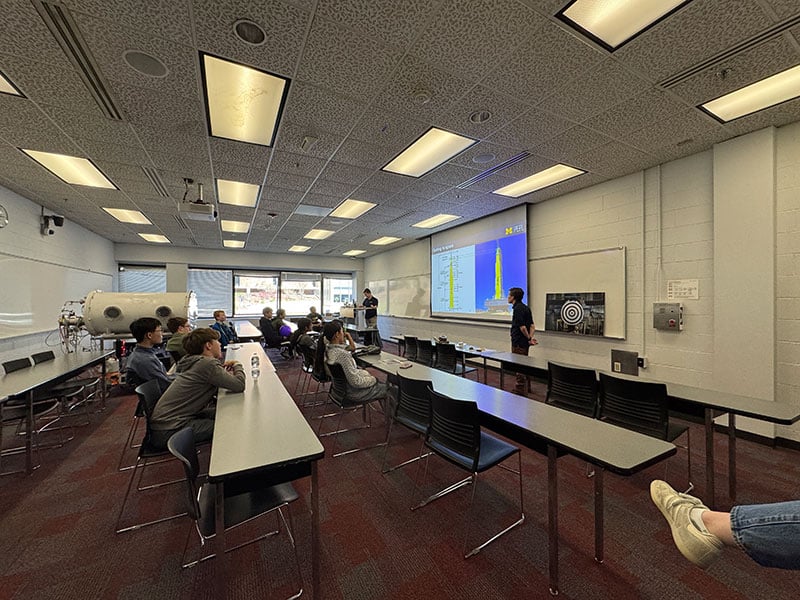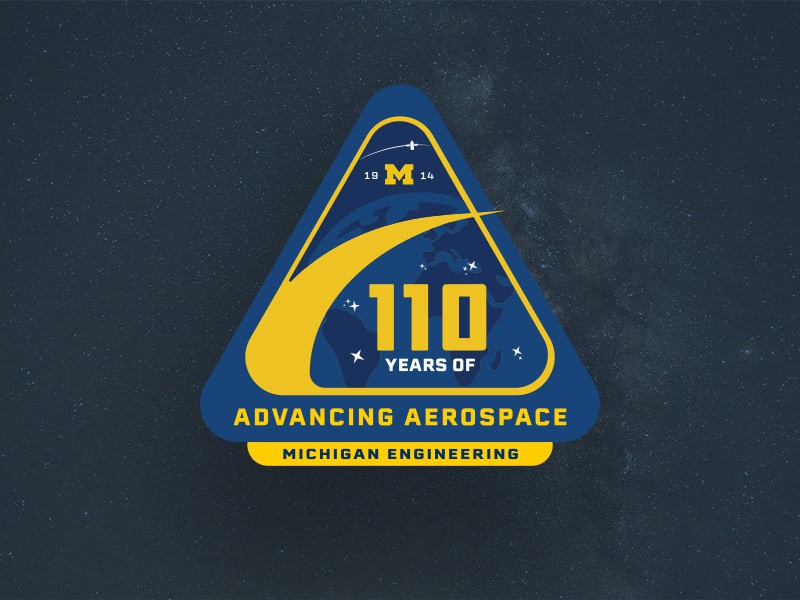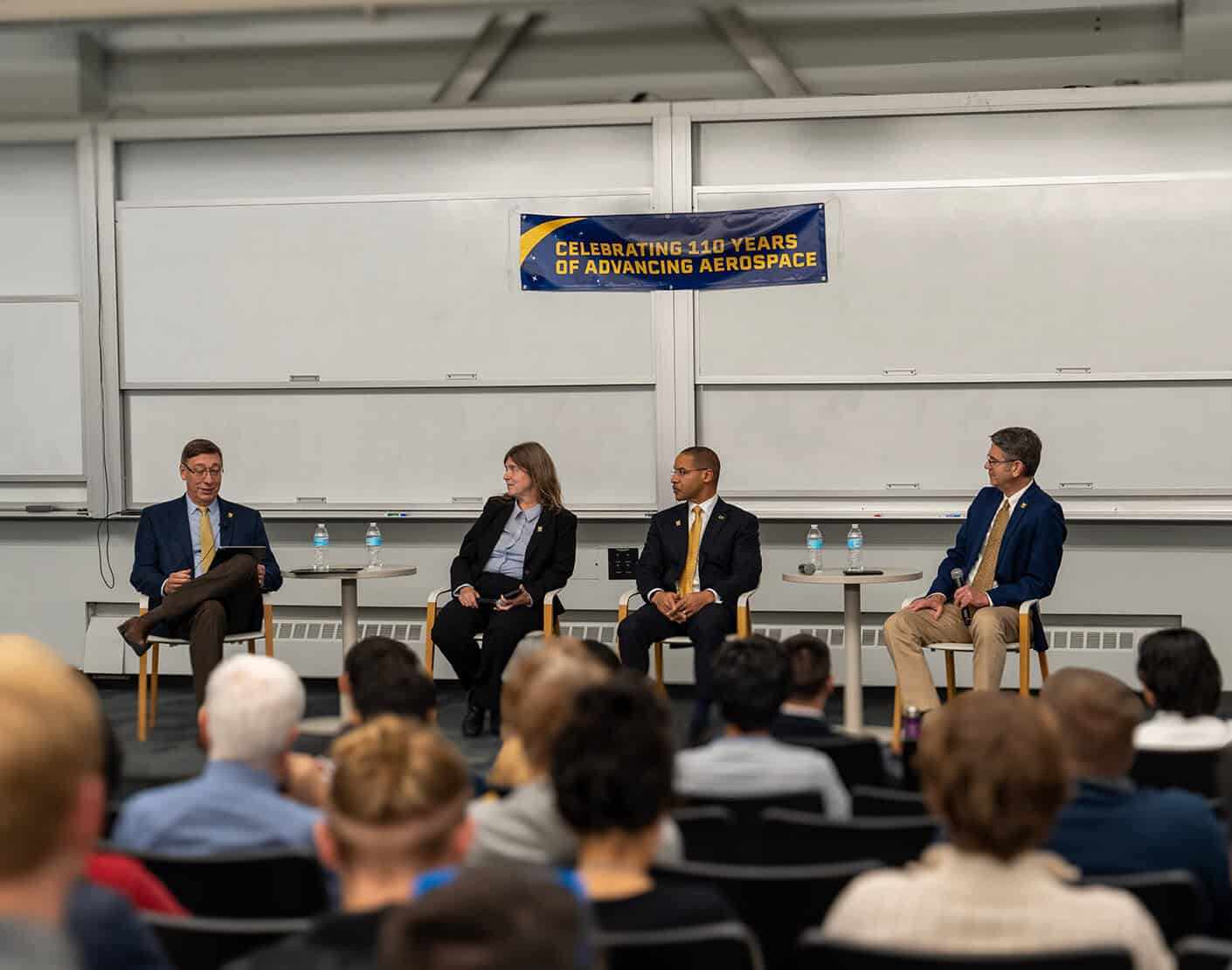110 Years of Advancing Aerospace
Shaping the Future of Flight Since 1914: Pioneering Aerospace Engineering at the University of Michigan
Since the department’s inception in 1914 as the nation’s first collegiate aeronautics program, Aerospace Engineering at the University of Michigan has been at the forefront of the fields of aeronautics and astronautics. This includes preparing flight leaders, equipping eventual astronauts, and helping to form young men and women into the individuals who go on to power the world forward.
As the department reaches 110 years of providing the highest quality of education to future aerospace leaders, the department is excited to reflect on how far they’ve come and what the future holds. This semester of events to mark the occasion will do just this, as a series of celebrations, symposiums, and panel discussions explore where society has been and where it can go.
We invite you to join us in this journey!
Upcoming Events
Diversity, Equity and Inclusion Panel Discussion
Tuesday, Sept. 24, 2024 | 12-1 p.m.
Robotics Atrium
Exploring how DEI has been a part of our department’s past, and how it will inform its future.
RSVP for the event
U-M Aerospace Engineering Technician Panel
Tuesday, Oct. 8, 2024 | 12-1 p.m.
Robotics Atrium
Discussing the physical history of the Aerospace Engineering department, its impact on campus, and the building the department inhabits.
U-M Aerospace Alumni Chairs Panel
Thursday, Nov. 7, 3-4 p.m.
Boeing Lecture Hall
Discussion between U-M Aero alums who have gone on to chair other Aerospace Engineering departments around the country.
Stories Celebrating Aero’s 110th
-

2025 Aerospace Day Welcomes Over 110 Students and Parents to the Department of Aerospace Engineering
U-M Chapter of AIAA organizations the department’s biggest annual outreach event
-

110 Years of Course Evolution in Aerospace Engineering
A look back in time at the first aeronautic course offerings and how they have evolved
-

110th Anniversary Chairs Panel Discussion: The Future of Aerospace Education
U-M Alumni now leading aerospace departments discuss topics shaping aerospace education and the industry’s evolution
Celebrating 110 Years of Aerospace Excellence: University of Michigan’s Pioneering Achievements and Innovations
Over the last 110 years, the field of aerospace has advanced from taking humanity’s first steps towards flight to exploring the farthest reaches of the known universe. During that time, the University of Michigan Department of Aerospace Engineering has supported or directly driven numerous innovations, breakthroughs, and milestones that are recognized to this day. Here is a look back on some of those noteworthy accomplishments.
1914: The University of Michigan establishes the first four-year aeronautical engineering program in the United States.
1926: The Guggenheim Fund for the Promotion of Aeronautics donates $60,000 to the University of Michigan, establishing one of the first wind tunnels in the country.
1929: Elsie MacGill becomes the first woman to earn a master’s degree in aeronautical engineering from the University of Michigan. She later becomes the first woman in the world to design airplanes.
1939: Dr. Felix Pawlowski, a professor at the University of Michigan, co-authors the first aeronautical engineering textbook in the United States, Aerodynamics.
1942: Clarence “Kelly” Johnson, an alumnus of the University of Michigan, designs the P-38 Lightning, a World War II fighter plane that becomes one of the most successful aircraft in history.
1945: Johnson designs the Lockheed P-80 Shooting Star, the first American jet fighter to see combat, revolutionizing military aviation.
1957: The University of Michigan’s Space Physics Research Laboratory is established, playing a crucial role in space research and satellite technology.
1960: Thomas Kaplan, a professor at the University of Michigan, pioneers work in supersonic and hypersonic flows, advancing knowledge in high-speed aerodynamics.
1962: The University of Michigan establishes one of the first plasma physics laboratories, contributing to advancements in space propulsion systems.
1965: James McDivitt, a University of Michigan alumnus, commands the Gemini 4 mission, during which astronaut Ed White performs the first American spacewalk.
1969: McDivitt commands the Apollo 9 mission, which tests the Lunar Module in Earth orbit, a critical step toward the Apollo 11 moon landing.
1970: The University of Michigan’s High Altitude Laboratory launches its first balloon-borne experiments to study the upper atmosphere, contributing to climate and weather research.
1976: The University of Michigan establishes the Space Physics Research Laboratory’s Space Shuttle Research Program, contributing to experiments flown on NASA’s Space Shuttle missions.
1983: Franklin Chang-Díaz, a University of Michigan alumnus, becomes the first Hispanic astronaut in NASA and later contributes to the development of advanced plasma propulsion systems.
1984: The University of Michigan becomes one of the first universities to offer a specialized program in computational fluid dynamics (CFD), revolutionizing aircraft design and simulation.
1986: The University of Michigan collaborates with NASA on the Space Shuttle Challenger accident investigation, contributing to safety improvements in spaceflight.
1990: Tony England, a University of Michigan professor and former NASA astronaut, flies aboard Space Shuttle mission STS-51-F, conducting important experiments in microgravity.
1995: The University of Michigan’s Solar and Heliospheric Research Group contributes to the design and development of the SOHO (Solar and Heliospheric Observatory) spacecraft, providing crucial data on solar activity.
1997: The University of Michigan’s Michigan Exploration Laboratory (MXL) is founded, focusing on small satellite design, development, and deployment.
2000: The University of Michigan establishes the Michigan Space Institute, advancing interdisciplinary research in space science, engineering, and policy.
2003: The University of Michigan leads the development of the Cyclone Global Navigation Satellite System (CYGNSS), a constellation of microsatellites used to study tropical cyclones.
2004: The University of Michigan’s MXL team successfully launches their first CubeSat, marking the university as a leader in small satellite technology.
2007: The University of Michigan’s Robert H. Lurie Nanofabrication Facility supports research in microelectromechanical systems (MEMS) used in advanced aerospace technologies.
2010: The University of Michigan collaborates with NASA’s Mars Science Laboratory mission, contributing to the development of the Curiosity rover.
2013: R. John Hansman, a University of Michigan alumnus, receives the FAA Excellence in Aviation Award for his contributions to air traffic control systems.
2015: The University of Michigan partners with SpaceX to conduct research on reusable rocket technology, contributing to advancements in space exploration.
2018: The University of Michigan’s Aerospace Engineering Department launches the “Aerospace Next” initiative, focusing on emerging areas such as autonomous flight, space resources, and green aviation.
2020: Michigan Aerospace Engineering alumni are instrumental in the Mars 2020 mission, contributing to the design and engineering of the Perseverance rover and Ingenuity helicopter.
2024: The University of Michigan celebrates the 110th anniversary of its Aerospace Engineering Department, reflecting on over a century of contributions to aviation, space exploration, and engineering innovation.